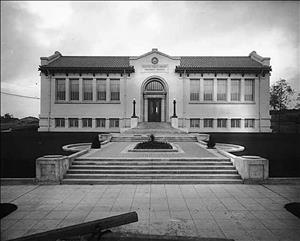Somewhere after a school, paved streets, and running water, a public library will also appear on the long list of desiderata for new and often remote neighborhoods. Actually, in the expectedly erudite University District, a branch library opened on University Way in the spring of 1906 before the street was paved. Within the year, the institution moved across the alley from the southwest corner of the “Ave” and 42nd Street into the Methodist Church on Brooklyn Avenue.
Three years more and the University branch of the Seattle Public Library dedicated (on August 5, 1910) its Carnegie endowment funded French Renaissance landmark. The building at the northwest corner of 50th Street and 10th Avenue NE (Roosevelt Way) was designed by architects W. Marbury Somervell and Joseph S. Coté. They were responsible, either as partners or separately, for five other Carnegie Branch libraries in Seattle as well.
The new library was located down the street from a dairy farm (at 55th and Ravenna). Mary Dennis was the first branch librarian in the new building, and Roberta Meredith served as branch librarian from 1927 to 1958.
Within the first year in the new building, the collection reached 7,631 volumes. There were 1,600 card-carrying readers, and some 44,000 books circulated. But the site was remote, from both the University District’s commercial heart along the “Ave” and from campus. As late as 1921, the branch librarian complained that it was “off the beaten track.”
However, following the 1922 opening of Roosevelt High School, students regularly swarmed the library searching for books on their namesake, Theodore Roosevelt -- probably an assignment -- then turning to other subjects for school reports and debates.
The branch was especially busy during the 1930s when people without jobs had more time to read books. On one day the line to check out books was 63 feet long. The Great Depression brought many donations of books and magazines to the library. During World War II, interest in nonfiction increased as people studied the places and issues that were part of the wartime news.
Cornelia and Watson Allen, the philanthropic couple who donated the site, made their gift contingent on the inclusion of an auditorium in the new library. Through the years the structure’s spacious basement auditorium has served as a community center for meetings, lectures, poetry readings, films, and children’s programs. During the two world wars, the big room was used by the Red Cross, a Well-Baby Clinic, and for meetings of the Women’s Air Raid Wardens and the Camp Fire Guardians.
It has recently been repainted and features a permanent exhibit on University District history.

